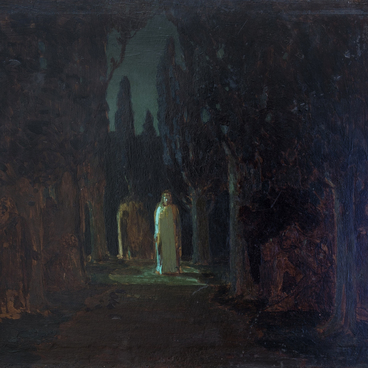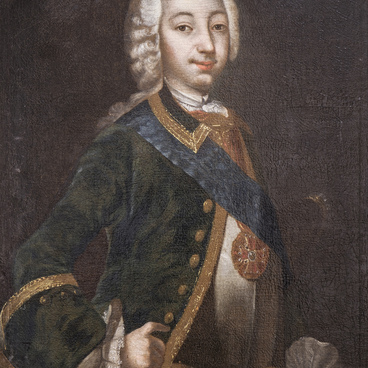This is a half-length portrait of a woman against a neutral dark background. She is depicted with her body turned slightly to the left. Her oval face is framed by black shoulder-length curls. She has black eyes, looking directly at the viewer, a straight nose, a small mouth, and a double chin. On her head, there is a small diamond crown. She also wears a silver brocade dress with a low neckline decorated with a dark blue ribbon over her right shoulder. On the left side, there is the Order of St. Andrew the Apostle the First-Called. On her shoulders, the empress wears an ermine mantle.
Anna Ioannovna ruled as Empress of Russia from 1730 to 1740. She was the middle child among the surviving daughters of Tsar Ivan V Alekseyevich and his wife Praskovia Fyodorovna Saltykova. She was also the niece and godchild of Peter the Great. After her father’s death, her uncle arranged for her to marry Frederick William, Duke of Courland and Semigallia. However, just two and a half months into their marriage, the duke died, and Anna proceeded to Courland. In 1730, after the death of her first cousin once removed, Peter II, Anna Ioannovna was invited to be the new Empress of Russia. She was selected by the Supreme Privy Council which gave her the status of a monarch with limited authority.
With the help of the nobles, the Empress restored autocratic powers and dissolved the Supreme Privy Council. Her reign is known as the “Bironovschina”, named after her lover Ernst Johann von Biron. With the help of Anna Ioannovna, he was elected Duke of Courland which he ruled from St. Petersburg.
The painting entered the Komi Regional Museum from the State Museum Fund in 1928. Later, in 1952, it was transferred to the Art Museum of the Komi Republic (now the National Gallery of the Komi Republic) as part of a collection of fine arts. Earlier, the portrait used to belong to the Ministry of Foreign Affairs.
The painting was in bad condition due to severe
deformation and poor adhesion between the original and additional canvases. On
the surface of the painting, there was a fine pattern of dense cracking —
craquelure. The paint layer was peeling off and crumbling along with the
primer. All of this was fixed during restoration.


